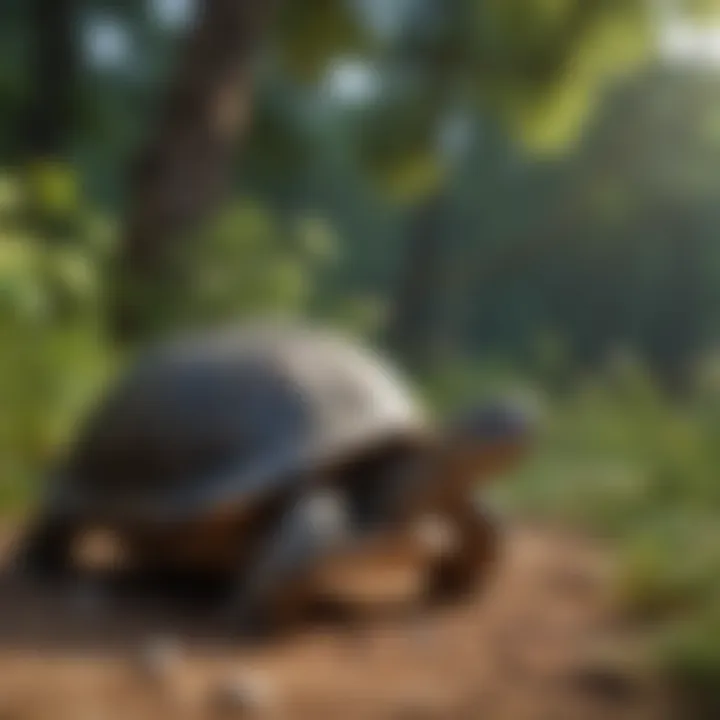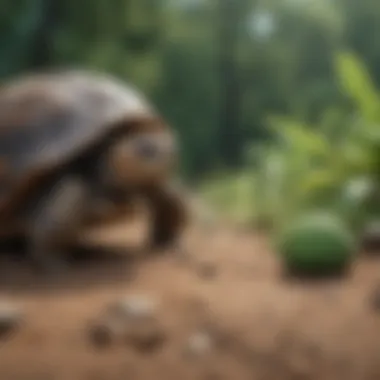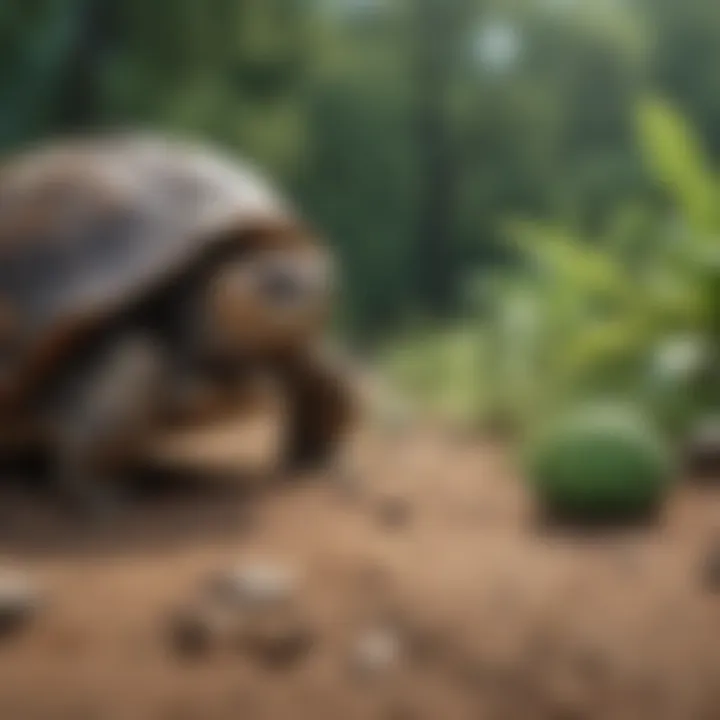Tortoise Housing Outdoors: Essential Guide for Owners


Intro
Creating an appropriate outdoor housing for tortoises demands a deep understanding of several fundamental aspects of their care. From the environmental conditions to design specifications, each consideration plays a decisive role in the well-being of the tortoises. This guide is tailored to helping owners construct safe, enriching, and sustainable habitats for various tortoise species, ensuring the reptiles thrive in their outdoor environments. It will cover tips on care routines, behavioral insights, nutrition guidance, wellness checks, and enrichment activities, all aimed to enhance the life quality of tortoises.
Care Tips
Handling the daily care of tortoises requires structured routines. Owners should ensure regular feeding, monitoring temperatures, and providing fresh water.
- Daily Care Routines: Owners need to establish a period for feeding and observe tortoises during sunlight hours. Development of habits helps both owner and tortoise align more with natural behaviors.
- Cage Setup and Maintenance: A stable outdoor enclosure must include natural elements such as dirt, plants, and shelters while also being securely fenced to prevent escapes or predation. The space needs comfert in sun and shade that manage temperature effectively.
- Hygiene and Cleaning Practices: Regular cleaning is crucial to maintain a healthy living environment. Owners should regularly remove waste and replenish bedding to avoid health hazards for tortoises.
- Seasonal Care Adjustments: Concrete strategies to protect tortoises should adjust seasonally. In colder months, proper heating and protection are essential to prevent ailments due to low temperatures.
Behavioral Insights
Understanding tortoise behaviors can yield valuable insights into their needs and emotions:
- Understanding Tortoise Body Language: Tortoises communicate through movements. Observing their demeanor can enhance caring strategies.
- Common Behavioral Issues and Solutions: Issues such as burrowing or aggression may arise if their habitat lacks enrichment. Addressing such behaviors early is important.
- Positive Reinforcement Techniques: Using rewards encourages desirable behaviors among tortoises during feeding decisions and interactions.
- Social Interaction Needs: Some tortoise species are gregarious in nature. Recognizing these needs can facilitate better group living or appropriate separations if aggression occurs.
Nutrition Guides
Feeding tortoises properly validates their health and longevity:
- Essential Diet Components: A lot of leafy greens, vegetables, and appropriate fiber sources is vital for optimal digestion.
- Safe and Toxic Foods: Knowledge of which plants are safe or harmful to tortoises should guide diet planning. Resources such as Wikipedia [1] can be helpful.
- Supplements and Treats: Calcium and mineral supplements should be included in diets regularly. Occasional treats like fruits can be delightful, but these are not to be overdone.
- Feeding Strategies for Different Species: Tailoring diets to specific tortoise species will provide comprehensive benefits, understanding the climate where they originate influences dietary wishes.
Wellness and Health
Regular monitoring can assist in the early detection of health concerns:
- Routine Health Checkups: Periodic evaluations can ensure tortoises maintain an optimal condition for better management of potential issues as they arise.
- Identifying Symptoms of Illness: Owners should become acquainted with common signs of illness, including behavioral changes or appetite issues, to act quickly when needed.
- Preventative Care and Vaccinations: Humans need to prioritize healthcare provided to the tortoises through the vets for potential vaccinations based on need.
- Mental and Emotional Well-being: Ensuring that tortoises have plenty of interactive time reduces stress and positions them to feel secure in their environment.
Enriching Activities
Create a stimulating environment:
- Toys and Playtime Ideas: Simple toys or even digging areas can provide tortoises with stimulation, the actions must reflect their need to explore.
- Training and Tricks: Encouraging simple actions through gradual, gentle training can strengthen the bond with pet tortoises.
- Outdoor Activities and Interaction: Weather permitting, outdoor exploration can enrich their experiences and align with their growth in open spaces.
- DIY Projects for Mental Stimulation: Sandboxes or tunnels that mimic natural environments can greatly enhance the lives of tortoises at home.
Proper housing provides a foundation for the well-being of tortoises and affects the lives of their owners – knowledge translates into effective care.
Prolusion to Outdoor Tortoise Housing
Creating suitable outdoor habitats for tortoises is vital for their health and well-being. This aspect connects to both an animal's natural behavior and the desire of caretakers to provide enriching environments. Understanding the specifics of outdoor tortoise housing addresses various needs and behavioral tendencies of different species.
In the process of designing an outdoor enclosure, it is essential to recognize the unique requirements of each tortoise species. Factors such as body size, climate adaptability, and social behavior play crucial roles. By tailoring housing solutions accordingly, owners can help minimize stress levels in their reptiles.
Understanding Tortoise Species
Tortoises come in many species. Each has different habitat preferences. Some larger species require more space. Species such as the African spurred tortoise thrive in warmer conditions compared to the California desert tortoise, which enjoys cooler environments. The more owners know about specific requirements, the better the conditions can be arranged.
It is also crucial to consider dietary habits. Some tortoises have specialized diets that require specific types of vegetation. Including a variety of plants in the habitat enriches their diets and contributes to their general health.
Benefits of Outdoor Housing
Housing tortoises outdoors offers numerous advantages. An outdoor setting provides natural sunlight. Solariity helps to promote the production of vitamin D, which is essential for shell health. Tortoises benefit from the natural temperature changes that occur outdoors. Seasonal variations can be crucial for natural hibernation patterns.
Another significant benefit is space. Outdoors, tortoises have the opportubity to roam freely. It encourages physical activity and more natural behaviors. An enriching environment supports mental and physical stimulation, leading to happier and healthier tortoises.
Some drawbacks exist, such as exposure to harsh weather and predators. However, with proper guidance in habitat design and the right necessities, these can be effectively addressed. Ultimately, understanding outdoor tortoise housing ensures a safe, sustainable platform, especially concerning different tortoise species and environmental adjustments.
Selecting the Right Location
Selecting the right location for outdoor tortoise housing is paramount for the well-being of your pet. Tortoises rely heavily on their environment to thrive. Each factor, from sunlight to shelter, plays a crucial role in their health and happiness. Therefore, careful consideration must be taken when determining where to place your tortoise habitat. In this section, we delve into several essential elements to consider when choosing the appropriate location.


Sunlight and Shade Considerations
When assessing the ideal location, understand that tortoises require a balance of sunlight and shade. Enough sunlight is vital for their metabolic processes, especially in warmer climates. A basking area should offer unobstructed sun rays for a portion of the day. Yet, it's equally critical to have cool shaded areas available. This shading allows them to retreat from extreme heat. Observe the daily sun patterns in your yard. Position their enclosure to maximize sunlight in the morning while offering shelter during peak afternoon heat. Proper sunlight and shade arrangements protect them from health issues associated with temperature extremes.
Protection from Predators
Another critical aspect is ensuring a safe environment. Outdoors, tortoises can be vulnerable to several predators like raccoons, hawks, or even neighborhood pets. An effective enclosure should ideally include a sturdy fence and roof to deter larger predators. Always inspect the area for ongoing signs of wildlife that may pose a risk. Utilizing materials such as galvanized hardware cloth can be beneficial. Be conscious of potential holes in the ground or low bush areas where predators may invade unnoticed. Secure protection not only safeguards the tortoise's life but also gives owners peace of mind.
Access to Water Sources
Tortoises require fresh water access at all times. The location you choose must allow quick and easy access to a water source, ensuring hydration needs are met. Even in the absence of a dedicated pond or pool, a shallow bowl placed in the habitat can suffice. It's vital to refresh the water daily, discouraging stagnation that can come with impure environments. During warmer months, a small water feature can also significantly enrich the habitat. This enhances their enjoyment while allowing them necessary cooling opportunities to help manage hot temperatures.
Key Takeaway: Focus on both sunlight access and safety measures when selecting the outdoor housing location for your tortoise. A balanced environment fosters health and happiness.
To summarize this section, ensuring a robust location setup enhances all aspects of tortoise care. Pay attention to sunlight exposure, safety from predators, and hydration necessity for a thriving outdoor tortoise habitat.
Designing the Habitat
Designing an appropriate habitat for tortoises is fundamental for their overall well-being. An ideal environment accommodates their behavioral and physical needs. Considerations for habitat design include size, shape, and availability of resources. A well-structured habitat not only enhances the quality of life for your tortoise but also makes maintenance easier for the caregiver.
Enclosure Size and Structure
Choosing the right enclosure size is critical. Tortoises require ample space to move and explore naturally. A spacious habitat allows them to exhibit various behaviors, which is essential for their mental health. The standard recommendation is to provide at least 10 square feet of space per tortoise to start. However, more space is always better.
The structure of the enclosure also matters. It should be strong enough to prevent escapes and protect the tortoise from potential threats. Use sturdy materials like wood or heavy-duty plastic. Make sure there are no sharp edges that could injure the tortoise. Including vertical elements such as ramps or stacked stones can provide varying levels of activity within the space.
Soil Type and Composition
Soil plays a vital role in creating a natural environment. Tortoises typically enjoy digging and burrowing. Therefore, the substrate of your habitat should allow for these behaviors. A mix of topsoil, sand, and organic material generally works well. This combination promotes drainage while retaining moisture adequately. Additionally, avoid using chemical fertilizers and pesticide-treated soil to ensure their health.
It is beneficial to monitor soil composition regularly. Changes in humidity and temperature can affect the soil's condition. Maintaining a balanced environment helps support beneficial microfauna, which contributes to the overall health of the habitat.
Shelter Options for Tortoises
Every tortoise needs areas to seek shelter from sun and rain. The shelters should be constructed from insulating materials to avoid heat extremes during both summer and winter months. Basic options can be wooden boxes, terracotta pots or even a log. Construct the hideouts to ensure they are low and accessible, mimicking the natural places where tortoises might find refuge.
Additionally, placing two or more shelters is advisable, especially in larger habitats. This allows the tortoise to choose where to retreat, catering to its instinctual demand for privacy and security. Ensure that the shelter is always dry and clean to prevent health problems, supporting the overall welfare of the tortoise.
Proper shelter in the habitat allows tortoises to express innate behaviors and reduces stress exposure.
Environmental Enrichment
Environmental enrichment plays a crucial role in the overall wellbeing of tortoises housed outdoors. It refers to enhancing their habitat in a way that fulfills their physical and psychological needs. When properly managed, natural elements can stimulate tortoises, facilitate natural behaviors, and decrease unwanted stress. Enrichment not only benefits their health but also supports their longevity.
Incorporating Natural Vegetation
Vegetation serves multiple purposes in the habitat of tortoises. First, it provides essential food items such as grass, weeds, and flowers, all of which are a significant part of their diet. Incorporating native flora can positively impact their nutrition. Specific plants like dandelions and clover are popular choices but should be checked for pesticide residues.
It's also valuable to consider the structure and density of vegetation.
- Forested areas can establish microhabitats, which often retain humidity.
- Thorny bushes may act as protection against potential predators.
- Dense foliage allows tortoises to exhibit their natural hiding behaviors.
The shape of the vegetation layout matters. Clumping plants together might create natural islands of shelter that tortoises can navigate. Ultimately, the more variety and structure offered by vegetation, the more interesting and beneficial the habitat.
Creating Hideouts and Basking Areas
The primary goal for any tortoise's hideout is security. Tortoises thrive in places where they feel safe from the elements and avoid predation. Natural elements offer cover, but crafted hideouts can serve that purpose too. Items like wooden planks or half-buried logs create shaded spots where tortoises can retreat.
In contrast, basking areas require careful attention to sun exposure. Tortoises need to regulate their body temperatures effectively, requiring sunny spots for basking. Here are a few tips:
- Establish basking platforms made of smooth stones or wood that can absorb warmth.
- Position these areas to ensure they receive ample sunlight in the morning while retaining shaded options nearby for after they have warmed.
- Monitor the placement, as changes in surrounding vegetation can alter light availability throughout different seasons.


A well-designed habitat includes natural hiding places and proper basking areas to help their well-being and quality of life.
In summary, the environment's overall richness plays a vital part in outdoor housing for tortoises. By including diverse vegetation along with effective hideouts and basking areas, you create a better, more enriching life for your reptiles.
Temperature and Humidity Management
Temperature and humidity are vital components in the wellness of tortoises. These factors significantly influence not only daily activities but also metabolic functions and overall health. Careful regulation of both elements ensures that these reptiles thrive and lead healthy lives in their outdoor settings. This section will explore the importance of temperature needs and humidity levels for tortoises and outline how owners can effectively manage these critical environmental aspects.
Understanding Temperature Needs
Tortoises are ectothermic animals, meaning they rely on external sources to regulate their body temperature. It is crucial to create a temperature gradient within their housing. This allows them to move freely between warmer and cooler areas as needed. A basking spot should be provided where tortoises can enjoy intense heat, generally ranging from 85°F to 95°F, depending on the species. Depending on the time of year, such a spot could ideally be created using sunlight exposure or heat lamps.
On the cooler side of the enclosure, temperatures should remain stable within the range of 70°F to 80°F to avoid stress. Any drops in temperature can lead to hibernation-like states, which might be harmful for active reptiles. Providing accessible heated shelters, or insulated areas outside that offers protection during cooler mornings and nights, is beneficial. Keeping temperature records can help confirm that these reptiles always have suitable conditions available.
Maintaining Proper Humidity Levels
Humidity levels play an equally important role in tortoise health. A relative humidity of about 40% to 70% is typically optimal depending on the tortoise species. Dry conditions can lead to shedding problems, dehydration, and potentially serious respiratory issues. Depending on the climate, owners might have to adjust their humidity regulation strategies throughout the year.
There are several methods to maintain this ideal humidity:
- Misting the habitat: Handheld misting devices or automatic misting systems can be effective.
- Water features: Including shallow drinking dishes or ponds also increases humidity while ensuring adequate hydration.
- Soil choice: Using substrates that retain moisture will help naturally balance humidity levels in outdoor enclosures.
Monitoring humidity with hygrometers is vital for keeping an eye on these levels continually.
Regular observation can help identify inconsistencies in temperature or humidity, preventing health issues before they arise.
Safety and Security Measures
Creating a safe outdoor environment for tortoises cannot be understated. The need for safety and security is crucial not just for the well-being of the tortoises but also for the peace of mind of their caretakers. A well-planned tortoise habitat ensures that these reptiles remain protected from predators, harsh weather conditions, and escapes while fostering a healthy living space.
Preventing Escape
Tortoises have a tendency to wander, and if the enclosure does not maintain robust boundaries, they can easily escape. Choosing the right enclosure is a primary consideration. It should be high enough, often at least a foot tall, and deep enough to prevent burrowing underneath. Ideally, an enclosing fence or wall should be made of solid material, as options like wire mesh may be inadequate. Consider utilizing layers: a bottom layer of wire or cinder blocks can deter digging.
Furthermore, the design of the habitat should be worded for curiosity and safety.
- Level Ground: Make sure the enclosure is away from places where debris or other structures could provide escape routes.
- Secure Hinges: If there are doors, check that they have reliable locking mechanisms.
- Desktop Sight: Test whether what a tortoise sees inside makes them interested enough to escape or if it presents too many risks. Use distractions within the habitat to keep them busy and less eager to leave.
By controlling these factors, owners can significantly minimize the risk of an escape.
Monitoring for Health Issues
Health monitoring within tortoise housing is critical. Regular health assessments can catch issues early and allow for timely intervention. Incorporate suitable routines:\n
- Daily Observation: Look for signs of lethargy, unusual behavior, or changes in feeding habits. Tortoises may hide illnesses until they become severe, therefore consistent inspection matters greatly.
- Cleaning Schedule: A clean environment can help reduce the chance of diseases. Daily cleaning helps prevent the build-up of waste, which can harbor harmful bacteria. Proper filtration of water should also be separately maintained.
- Temperatures and Behaviors: Consistent typing notes about temperature and any behavioral change provides a clues to health conditions. Observing patterns will tell us what is 'normal' for an individual tortoise and allows comparison in case concerns arise.
It is essential to understand normal parameters. Proactive engagement in their environment helps keep the tortoise healthy. For pet owners listening and recording their animal's behavior intensively keeps both tortoise and homes secure and healthy.
Keeping tortoises safe is more than just about structure; it involves active ongoing observance of their environment and physiological cues. Their survival depends heavily on these nuanced shop engaging practices.
Maintenance of Outdoor Housing
Maintaining outdoor housing for tortoises is not merely a matter of aesthetics; it plays an essential role in the health and well-being of these reptiles. Over time, debris, waste, and parasites can build up in the habitat. These elements do not only diminish the quality of the environment but can also impact the tortoise's health. Regular maintenance ensures that the tortoise’s luxuries—clean spaces to roam and appropriate shelters—are preserved.
One of the most significant benefits of routine maintenance is the prevention of health issues that can arise from unsanitary living conditions. Cleanst enviroments reduce stress and diminish chances of insect infestation. Furthermore, monitoring the housing closely allows for early detection of any structural issues.
Considerations here are broad and can include:
- Ensuring habitat cleanliness to minimize disease risk.
- Regular checks and repairs of enclosures to prevent escapes.
- Upgrade maintenance when required due to wear and environmental stressors.
Regular Cleaning Practices


Establishing an effective routine for cleaning your tortoise's habitat is vital. The process isn't particularly arduous but does require attention to detail and consistency.
Start with the physical cleaning. Remove any uneaten food and feces daily. This prevents odors and helps with overall hygiene. Once a week, perform a more thorough cleaning which can involve:
- changing the bedding materials
- scrubbing down surfaces with non-toxic cleaners
- rinsing enclosures to remove bacteria.
Always monitor the water supply for clarity and frequency of changes. Clean water encourages hydration and overall health. The type of bedding also plays a part in maintenance, with some bedding materials like straw fielding odors more chronically if not changed regularly. This is especially true in humid or rechnlu-ci heavy regions.
Be cautious when moving tortoises during cleaning. Provide alternative safe enclosure during this period to ensure their security and stress reduction.
Seasonal Adjustments
Seasons can influence numerous factors related to outdoor tortoise housing. Adapting the habitat to conform to winter conditions or summer heat is crucial for well-being.
In summer:
- Increase shade areas as temperatures climb.
- Provide access to a water dish to promote hydration.
- Consider purchasing or constructing additonal shade cover, using something like canopies or vegetation covers.
During winter:
- Add insulation to housing structures to retain heat on colder nights.
- Monitor humidity levels more carefully than in the warmer seasons.
- Ensure that the water supply does not freeze, as tortoises will need access to liquid during all seasons.
By being aware of changing environmental conditions through the year, homeowners can better fulfill the needs of their tortoises. Adjusting hollows or shelters can mimic naturally occurring behaviors 一 offering a richer environment.
Overall, diligent maintenance can make a meaningful difference in the life of your tortoise. Through regular cleaning and respectful seasonal adjustments, you foster a safe habitat that supports their natural behaviors and health.
Common Mistakes to Avoid
Creating a suitable outdoor housing for tortoises involves thought and reasoning. New and experienced caretakers often make common mistakes that implicate the well-being of these reptiles. Understanding these mistakes helps in fostering a more enriching environment. By avoiding pitfalls, owners can create habitats that serve their tortoises' needs effectively.
Overcrowding the Habitat
One key error that many tortoise owners commit is overcrowding. Housing multiple tortoises in too small an area can lead to stress and aggressive behaviors. Tortoises are solitary creatures by nature and need their own space. If they are too close to one another, competition over resources like food and basking areas increases.
Ensure that each tortoise has a noticeable space to roam, bask, and rest. Generally, a larger enclosure is better, allowing each tortoise its own territory. A good rule of thumb is to allow at least 10 square feet per tortoise. This spatial requirement varies by species but is vital for their comfort and relaxation. Not adhering to these spatial rules can lead to injuries, broken shells, and even health issues derived from chronic stress.
Proper spacing improves their overall quality of life, creating a natural environment where they can behave normally. Considerations for the habitat size should factor in the possibility of growth, as many tortoise species do not remain small.
Ignoring Local Climate Conditions
Ignoring the local climate can greatly affect how well tortoises adjust and thrive in their housing. Each species has its specific needs regarding temperature and humidity; neglecting these can lead to health complications. In a substantial number of cases, tortoise owners place animals outside without accounting for extreme weather fluctuations.
For instance, typical Mediterranean species appreciate dry, warm conditions but may suffer in prolonged humidity coupled with freezing temperatures. Ensure that the habitat includes adequate shelter from extreme temperatures, both hot and cold. Moreover, areas of shade should be ample for daytime use during the warmer months.
Here are some points to keep in mind:
- Always check the forecast.
- Provide shaded areas for rest.
- Use substrates that absorb moisture without becoming swampy.
Consider consulting local guidelines concerning tortoise care, which can often provide specifics for certain environments. By adhering to local climate standards, the tortoises facing unfavorable conditions can be substantially reduced.
A suitable outdoor habitat considers all weather aspects, enhancing the well-being of your tortoise in every season.
Thus, important tips for optimization involve proper spacing in the enclosure and adherence to unique climate needs of each tortoise species. Avoiding these mistakes gives direct benefits to both tortoise and owner, securing health, longevity, and ease of care.
Finale
Creating suitable outdoor housing for tortoises involves complex factors that directly impact their health and well-being. In this article, we explored various aspects, emphasizing the unique needs of different tortoise species and the importance of environmental considerations. Establishing a safe, enriching, and sustainable habitat is essential.
A well-designed outdoor environment enhances the quality of life for tortoises. It allows for natural behaviors such as foraging, basking, and hiding, which are crucial for their physical and mental well-being. Proper temperature and humidity management ensures that tortoises thrive in their habitats, securing good health. Understanding local climate conditions is equally important; ignoring these factors can lead to detrimental effects on tortoise welfare.
Moreover, regular maintenance practices protect against health issues and ensure a clean habitat. Being aware of common mistakes, such as overcrowding and neglecting to secure the enclosure, supports a better experience for caretakers.
Outdoor tortoise housing is not merely a matter of keeping these reptiles. It's about creating a rich, engaging environment tailor-made for their needs. In loving and informed ways, care providers can significantly boost their tortoises' quality of life.
“An informed approach leads to a thriving ecosystem within your backyard, enriching both the tortoises and their owners.”
To truly appreciate the benefits of outdoor tortoise housing, the synthesis of environmental design, monitoring, and ongoing attention to detail is paramount. It's not only about the space but the health, security, and happiness of these remarkable creatures.















